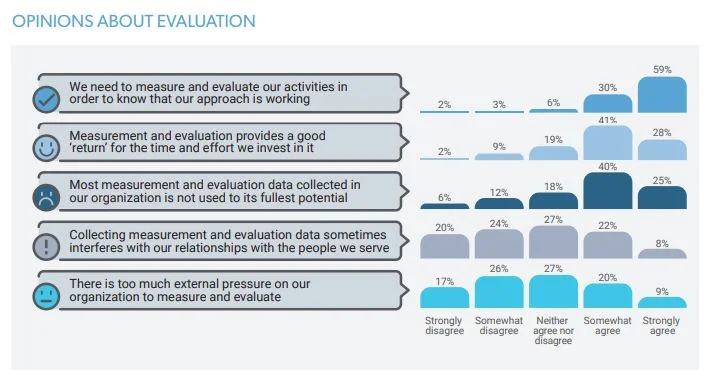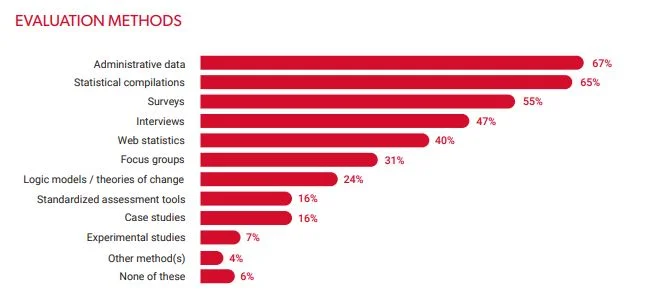RESEARCH — PART I — WHAT WE CAN LEARN FROM OUR FRIENDS IN THE PRIVATE SECTOR
RESEARCH — PART I — WHAT WE CAN LEARN FROM OUR FRIENDS IN THE PRIVATE SECTOR
Andrea McManus, ViTreo Group Inc
April 16th 2019
For the past several weeks, The Provocateur has focused on a series of Courageous Conversations we need to have to step up our game. This next series on research delves further into this, into methods we can use to raise the bar for ourselves and at the same time, tell the story, the really important story, of our impact on the world - to our external stakeholders - in a more meaningful way. Throughout the series, we’ll also have guest bloggers sharing their thoughts on research and why it matters to our sector.
Demonstrating our impact. How do we accomplish that? One way is to learn from the for profit sector, some of whom will have their feet held to the fire by shareholders or employers if they don’t provide a clear picture of methods, expenses, etc. They need to provide a return on investment (ROI). And if they do that, and there’s a healthy increase in share price or in the bottom line, their stakeholders tend to be happy.
Not so in the nonprofit world. Expenses. The cost of fundraising. Impact. We’re constantly challenged to justify the first two with often scant attention paid to the third. This makes no sense to me. I talked about this just last week while appearing before the Special Senate Committee on the Charitable Sector (My part begins at 16:03.05.).
If a nonprofit spends $20 million to raise $10 million, but the funds raised are targeted towards a program that, as a result of the funds, cures a specific type of cancer or ends poverty in third world countries, what difference does it make that our expenses double the final tally? We’ve cured the cancer. We’ve ended third world hunger. No one has to die or suffer from that kind of cancer ever again; babies, children and adults in Africa are no longer starving to death. Unlike share price or revenue, we can’t double or triple the result. We have achieved the impact we sought. We got the result we wanted from our fundraising. So, why are we still having this conversation?
But we are. And for many of our stakeholders, it does seem to matter and so we need to change what we’re doing, because we haven’t changed their perspective. Perhaps in time, we will. For now, we need to work with what we have. We need to tell a story they will understand. A story that makes sense to them.
From an article in Hillborn Enews on Imagine Canada’s Research and the State of Evaluation in Canada report:
“Increasingly, charities are being asked to demonstrate the impact of the programs and services they deliver. Beyond descriptions of the programs and services they offer, tabulations of the number of clients served, or stories about the organization’s impact on individuals, organizational stakeholders (funders, board members, policymakers, members of the media, and individual Canadians) are hungry for information to help them understand how the charities they support are affecting both the populations they serve and the broader social, economic, and environmental systems they are embedded in.
Repeatedly during Imagine’s work to help establish a new narrative for charities and the charitable sector, participants and informants told us that being able to demonstrate these types of impact is critical to successfully reshaping the charitable sector’s conversation with Canadians. However, during our day to day interactions with charity leaders, many (particularly those leading smaller charities) tell us they struggle to do this. This is not because they are not measuring and evaluating their work and it is certainly not because their work is not having an impact. Instead, they struggle with demonstrating impact as part of a broader set of challenges related to measurement and evaluation. Looking at the evaluation landscape, they see a diverse range of potential approaches and techniques they could apply, an even wider range of possible uses for the results produced, and an incredible diversity of stakeholders and audiences to engage with. Faced with a sometimes overwhelming range of potential options and demands, what charity leaders need is a common understanding with their stakeholders of what norms and expectations are reasonable for their organization and circumstances.”
source: Hillborn Enews, Research | State of Evaluation in Canada, April 02 2019)
As the Imagine Canada report states above, we need to develop a common method of communicating our impact with stakeholders. My suggestion is that we look to the private sector for methods to evaluate our results and then again on how best to demonstrate our ROI to our stakeholders.
The fundraising sector and nonprofits must operate in a similar fashion to businesses for long-term success. In the for profit world, ‘measurement’ is king - consistent and ongoing measurement or evaluation of our (the nonprofit sector’s) results is critical. Data must be collected, then analyzed in order to identify outcomes for meaningful and accurate measurement so that we can demonstrate impact. Without that, we can’t know If we’re successful, if we’re making headway… and you know what Einstein had to say about that…
“Let's face it; we are in a saturated market. Competition is fierce, and consumers, as well as donors, are very cautious about how to spend the money. To remain relevant and current in such a market, a nonprofit must impose business-like standards, because people will judge and compare them to such.
A nonprofit, like a business, has a board of directors, marketing and human resources departments, and decision-making executives, all geared toward understanding the market and making day-to-day choices that ultimately help us be more competitive and successful. These groups develop strategic plans, keep financial records and audits, and monitor compliance. So why treat it differently just because we are not in it to make a profit?”
According to Imagine Canada’s research, external funding plays a significant role in evaluation. It appears that those receiving external funding tend to allocate more budget to evaluation.
“While it is uncommon for external funding to include monies specifically for evaluation - just 20% of externally funded charities reported receiving dedicated evaluation funding - charities that receive this funding tend to evaluate more involved aspects of their work (such as their impact and return on investment) and to use more specialized evaluation methods. However, they do not seem to use evaluation findings differently.”
Imagine Canada’s report goes on to talk about not for profits who draw on a range of quantitative and qualitative methods and resources to evaluate their work and more involved approaches - focus groups, logic models, theories of change, and case studies. When buy-in to evaluation methods is created from leaders, staff and stakeholders, philanthropic organizations tend to move to even more specialized measurement.
A number of key enablers and barriers affect evaluation capacity.
The most important enablers are support from organizational leaders and buy-in from staff and stakeholders. Charities experiencing these key enablers are more likely to evaluate their impact, to use a range of more specialized evaluation measures, and to use evaluation results to communicate with less common audiences.
The most common barriers are lack of staff time and financial resources, but while these barriers are commonly reported they do not seem to be associated with significant differences in what charities evaluate, the evaluation measures they draw on, or how they use results.
And of course, organizations with a staff member dedicated to evaluation have more success and higher capacity with research and evaluation. In organizations with no staff dedicated to this role, it is frequently spread across several positions and often falls to the Executive Director or program staff or volunteers, with less success.
The report also found 22% of charities report having worked with an external consultant or organization in some capacity related to evaluation over the previous year which allowed them to measure more involved aspects of their work and drawing on more sophisticated methods and resources. Overwhelmingly, charities that work with external evaluators are happy about their experiences with them. Source: Imagine Canada, The State Of Evaluation Measurement And Evaluation Practices In Canada’s Charitable Sector, David Lasby et al, 2019
The full Imagine Canada report is a very worthwhile read. In it you will find:
Evaluation capacity of charities
Communications between funders and their fundees
Leadership support and buy-in for evaluation work
The role of networks and supports for charities
It can be downloaded from here.
We create risk for those we help and for ourselves unless we provide proof to funders and other external stakeholders. It’s true that people don’t make decisions based on facts, but on emotion, but we also need to back up our narrative. If we want philanthropists, foundations or government to continue to support us and to understand our work, we need to make this shift and to evaluate ourselves and our work at a deeper level.
Let me know if your organization provides a comprehensive measurement of the work it does and evaluates the results. And if so, what changes has that made for you and the community you are a part of?
The Provocateur is delighted to welcome Bernard Ross of =mc as next week's guest blogger. We're delighted to have him join us! Bernard is the author of Change for Good, a topic of critical relevance for how social purpose organizations can increase their impact, how we as human beings make decisions and how anyone involved in the field of social change can help individuals or groups to make positive choices using decision science.
Bernard is an internationally regarded expert in strategic thinking, organizational change and personal effectiveness. He works in Europe, USA, Africa and South America. His assignments have involved a wide range of not-for-profit organizations over 25 years. Those in the UK include British Red Cross, NSPCC, Macmillan Cancer, and the Science Museum. He has also consulted for a number of universities including Oxford and the Sorbonne. International agencies on his assignment roster include ICRC, IFRC, Amnesty International, Greenpeace International, UNICEF, and MSF. Bernard's areas of expertise include helping achieve radical change in culture, strategy/coaching CEOs and senior managers on influence and personal presence, developing innovation including new business models in organizations, and shaping large scale and global fundraising campaigns – up to US$50B.
Be sure to tune in for what will be a fascinating and provocative read!
Check out ViTreo's Braintrust as we bring you additional insights into what is and what will be important in philanthropy through our Weekly News Recap and our Podcast.
ABOUT THE AUTHOR
Andrea McManus, Chair, Board of Directors, Partner
ViTreo Group Inc
Andrea McManus is a Partner with ViTreo with over 30 years’ experience in fund development, marketing, sponsorship and nonprofit management. A highly strategic thinker and change maker, Andrea has worked with organizations that span the nonprofit sector with particular focus on building long-term and sustainable capacity.










